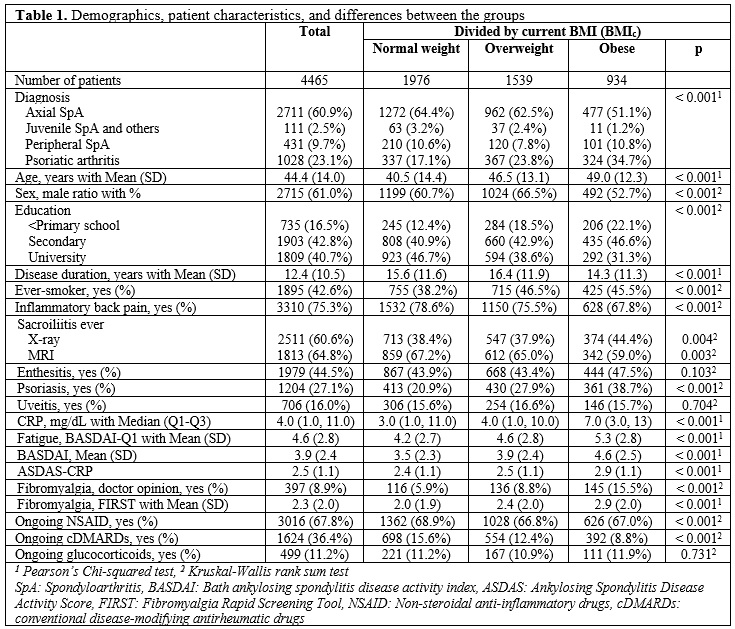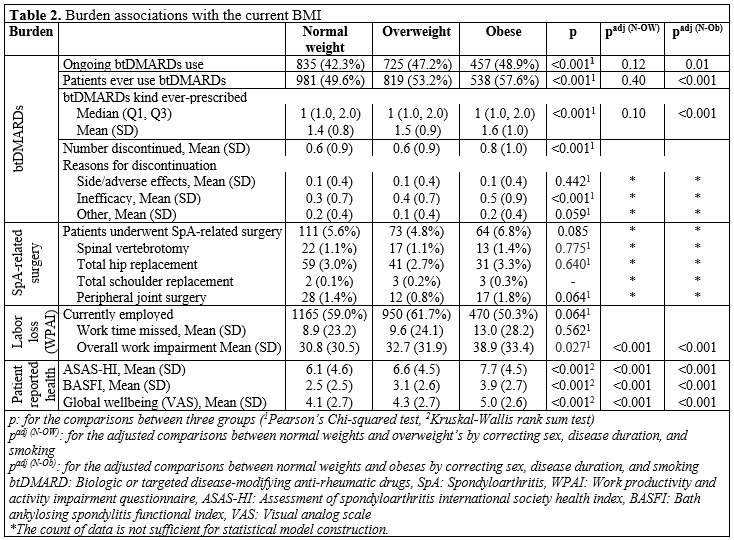Session Information
Date: Monday, November 8, 2021
Session Type: Poster Session C
Session Time: 8:30AM-10:30AM
Background/Purpose: Obese patients with spondyloarthritis (SpA) had more functional limitations, higher subjective disease activity, fewer benefits of exercise, and showed less response to drug therapy. This study aims to explore the relationship of obesity with clinical manifestations and disease burden including biologic/targeted DMARD (btDMARD) burden, SpA-related surgery burden, labor loss, and patient-reported health status.
Methods: An ancillary analysis of ASAS-PerSpA cross-sectional study from 24 participating countries. The ASAS-PerSpA study included the data of diagnosis, demographics, disease duration, clinical manifestations (ie, inflammatory back pain, sacroiliitis, enthesitis, psoriasis, uveitis, fatigue, and fibromyalgia assessment), disease activity, ongoing treatment and treatment history (ie, ongoing btDMARDs use, ever btDMARDs use, number of btDMARDs kinds ever-prescribed, number of btDMARD discontinuation, and the reasons for discontinuation), SpA-related surgery (ie, spinal vertebrectomy, total hip replacement, peripheral joint surgery), work productivity and activity impairment (WPAI) questionnaire, ASAS Health Index (ASAS-HI), Bath Ankylosing Spondylitis Functional Index (BASFI), and global wellbeing (on a visual analog scale). In addition to the current BMI (BMIc), the 20-year-old BMI (BMI20) data were also noted. Patients were divided into three groups according to the BMIc and comparisons between the obese patients (BMIc ≥30 kg/m2), overweights (BMIc ≥25 to < 30 kg/m2), and normal weights (BMIc < 25 kg/m2) were performed for the above-mentioned parameters. In addition, the same population was also divided into different three groups according to their BMI20 and they have compared again in themselves.
Results: A total of 4449 patients with the BMIc values were included. The mean age was 44.4 (SD 14.0) and 61.0% were male. The mean disease duration was 14.3 (SD 11.3) years and 42.6% of them were ever-smokers. Demographics and patient characteristics were demonstrated in Table 1. Comparisons of the disease burden according to the BMIc (Table2) and BMI20 (Table 3) documented the statistical significances between the groups.
Conclusion: Obesity is related to a biological (or targeted) therapy burden, labor loss, and worse patient-reported health status.
To cite this abstract in AMA style:
Duruoz M, Acer Kasman S, Gezer H, López Medina C, Dougados M. Obesity and Its Associations with Clinical Manifestations and Disease Burden of Patients with Spondyloarthritis: An Ancillary Study from the ASAS-perSpA Project [abstract]. Arthritis Rheumatol. 2021; 73 (suppl 9). https://acrabstracts.org/abstract/obesity-and-its-associations-with-clinical-manifestations-and-disease-burden-of-patients-with-spondyloarthritis-an-ancillary-study-from-the-asas-perspa-project/. Accessed .« Back to ACR Convergence 2021
ACR Meeting Abstracts - https://acrabstracts.org/abstract/obesity-and-its-associations-with-clinical-manifestations-and-disease-burden-of-patients-with-spondyloarthritis-an-ancillary-study-from-the-asas-perspa-project/



